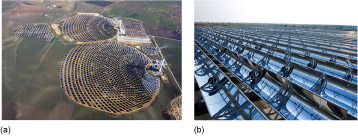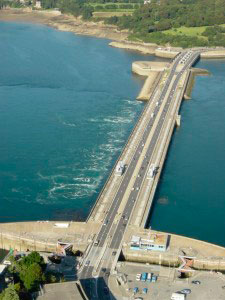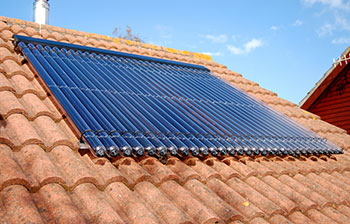5.7 Types of renewable energy
The most widely used fuel in the world is biomass – wood and vegetation. In developing countries, wood is the most widely available fuel, especially in rural areas; but unfortunately in many cases it is not used in a renewable fashion, resulting in deforestation. This has further knock-on effects, such as soil erosion and environmental degradation, which can be a significant problem. Properly managed biomass can be an important source of renewable energy. Several types of fast-growing trees are suitable for short rotation cropping, in which trees are harvested and replanted after about five years, or coppicing, in which the trees are regularly pruned and their branches harvested. Thus, there is no reduction in the number of growing trees. Other crops such as rapeseed and sugar cane are often grown for their oil, which has many uses, including fuel for transport. Sugar cane can also be converted into ethanol for use in motor vehicles.
In 2013, the most widely implemented renewable energy scheme for large-scale power generation was large-scale hydroelectricity, in which stored water is released downhill through generating turbines. Water gets into the high-level reservoir in two ways:
- directly, after falling as rain or snow on higher ground
- as part of a scheme where water is pumped from lower down when 'surplus' energy is available, to be released at times of peak energy demand.
In the latter case, the main purpose of the scheme is short-term energy storage, rather than to be a source of energy. However, most suitable hydroelectric sites have now been developed, and there are significant social and ecological problems associated with forming the reservoirs. Also, suitable sites tend to be remote from areas requiring energy.
Tidal barrage schemes are similar to large-scale hydro schemes, with the twice-daily tide carrying seawater into an adapted natural reservoir, which is drained via generating turbines. One such success, and a major engineering project, was the barrage across the estuary of the Rance just outside St Malo (Figure 92). But the potential for large-scale power generation in this way is not without major consequences for the environment because large areas of land must be flooded for the reservoir.
The smaller scale motion of the sea – wave power – may itself offer a useful way of generating electricity.
Wind mills and water mills have long been used to provide mechanical energy from renewable sources. In the UK and many other countries, wind farms in remote hilltop locations (as well as other, less remote sites) link mechanical energy through turbines to the electrical grid, and large offshore schemes, rated in hundreds of megwatts, are increasingly common. However, wind energy is a highly variable resource, and no wind turbine will ever be able to provide power 100% of the time.
This brings us on to solar power: energy directly from the Sun. Photovoltaics is the key to electricity generation directly from sunlight. As with wind power, though, the availability of solar energy is subject to variation, not just between night and day, but also as the length of day changes with the seasons, particularly at high latitudes. Solar power is also very dependent on the weather, though weather patterns are generally predictable over the longer term.
There are two technologies for harvesting solar energy. Solar thermal energy is used for space heating in passive designs of houses (e.g. just having south-facing windows), and in systems where solar energy is used to heat air in wall cavities, which is then actively circulated around the house (known as Trombe walls). Alternatively, active solar water heating with panels mounted on roofs will feed heated water either directly for use or via a heat exchanger for pre-heating domestic water; see Figure 93.
There are also large-scale applications. In some, an array of steerable mirrors is arranged to focus sunlight on a central tower where the concentrated heat drives steam turbines to generate electricity. In others, parabolic, tilting mirrors direct the light onto a pipe that carries a fluid that is cooled in a steam generator connected to a turbine. These systems, examples of which are shown in Figure 94, have to be big to minimise heat losses. Large solar thermal schemes are usually also able to store heat, either in the form of molten salt, or as superheated steam, to keep the turbines spinning at night or at other times when the solar energy input is less than the desired output of the plant.

Photovoltaic technology generates electricity directly from sunlight and is the main subject here. It is modular, i.e. it can be built up in small sections – and so is just as applicable to small-scale domestic application as to large power stations. Its chief benefits lie in its silent, pollution-free operation with almost zero maintenance and it is well-suited for use in urban environments. (A variant of the technology, thermo-photovoltaics, use a particular type of photovoltaic cells to turn radiant energy from any heat source into electricity. The heat source can be from fossil fuels or biomass as well as from concentrated sunlight.)
Because of its variable nature, renewable energy usually requires integration with so-called power conditioning – electrical engineering aimed at levelling the supply. This may involve energy storage systems, such as batteries, or the hydro-storage mentioned earlier, or the use of the mains network as a store so that power is exported to the grid at times of abundance and imported at leaner times.
Activity 42 (self-assessment)
- a.List four types of renewable energy.
- b.Give two advantages of photovoltaics compared to other renewable sources.
Answer
- a.Biomass, wind, solar, geothermal, hydro, tidal and wave are the principal ones. You may also have thought of ocean and thermal.
- b.There are several advantages: it is a modular system, so as many modules as required can be installed at a particular location; it is silent in operation; it is virtually maintenance free.


